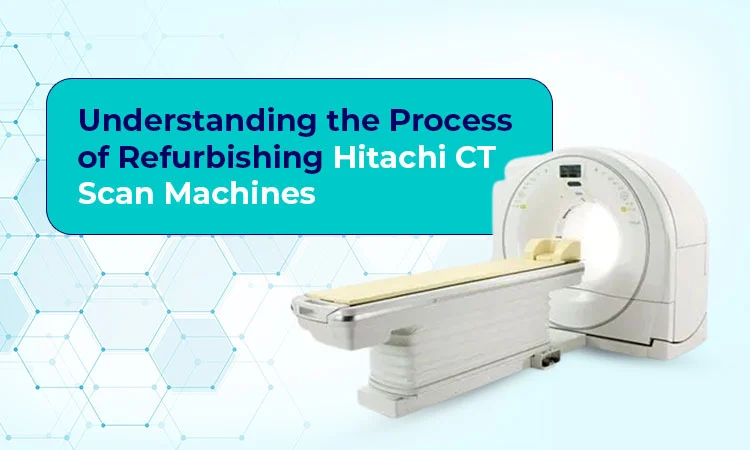Understanding the Process of Refurbishing Hitachi CT Scan Machines
In the realm of medical imaging, computed tomography (CT) scan machines play a pivotal role in diagnosing various medical conditions with precision and accuracy. Hitachi, a renowned name in the field of healthcare technology, offers advanced CT scan machines known for their reliability and performance. However, as with any sophisticated equipment, CT scanners require periodic maintenance and refurbishment to ensure optimal functionality and extend their lifespan. In this blog, we delve into the intricate process of refurbishing Hitachi CT scan machines, focusing on two prominent models: Supria and Scenaria.
The Significance of Refurbishing Hitachi CT Scan Machines
Discuss the importance of maintaining and refurbishing medical equipment for healthcare facilities.
Highlight the benefits of refurbishing Hitachi CT scan machines, such as cost-effectiveness, improved performance, and reliability.
Overview of Hitachi CT Scan Machines
Provide an introduction to Hitachi’s CT scan machines, emphasizing their features, capabilities, and applications in medical imaging.
Briefly describe the Supria and Scenaria models, highlighting their specifications and differences.
Initial Assessment and Evaluation
Explain the initial assessment process conducted by refurbishment experts to evaluate the condition of the CT scan machine.
Discuss the importance of assessing key components such as the gantry, detector, X-ray tube, and imaging software.
Disassembly and Cleaning
Detail the disassembly process, wherein the CT scanner is carefully dismantled to access internal components.
Highlight the significance of thorough cleaning to remove dust, debris, and contaminants that may affect performance.
Component Replacement and Upgrades
Discuss the identification of faulty or worn-out components that require replacement, such as X-ray tubes, detectors, and cooling systems.
Explore the possibility of upgrading certain components to enhance performance and compatibility with modern imaging technologies.
Calibration and Testing
Explain the calibration process, wherein the refurbished CT scanner undergoes rigorous testing to ensure accurate imaging and radiation dosage.
Highlight the use of advanced calibration tools and software to fine-tune various parameters and optimize image quality.
Software Updates and Integration
Address the importance of updating the CT scanner’s software to ensure compatibility with current operating systems and imaging protocols.
Discuss the integration of advanced software features for image reconstruction, post-processing, and data analysis.
Quality Assurance and Regulatory Compliance:
Emphasize the adherence to strict quality assurance standards and regulatory guidelines throughout the refurbishment process.
Highlight the certifications and accreditations required for refurbished medical equipment to guarantee safety and efficacy.
Final Inspection and Certification
Describe the final inspection phase, wherein the refurbished CT scanner undergoes comprehensive testing and validation.
Discuss the issuance of certification documents to validate the refurbished machine’s compliance with industry standards and specifications.
Installation and Training
Outline the process of installing the refurbished CT scanner at the healthcare facility, including site preparation, equipment calibration, and setup.
Highlight the importance of providing training to radiology staff on the operation, maintenance, and safety protocols of the refurbished machine.
Post-Installation Support and Maintenance
Discuss the significance of ongoing support and maintenance services provided by refurbishment companies to ensure the longevity and optimal performance of the CT scanner.
Address the availability of spare parts, technical assistance, and remote troubleshooting for any issues that may arise.
Case Studies and Success Stories
Present case studies or success stories showcasing the successful refurbishment of Hitachi CT scan machines and the positive impact on healthcare facilities and patient care.
Highlight specific examples of improved diagnostic accuracy, reduced downtime, and cost savings achieved through refurbishment.
Future Trends and Innovations
Explore emerging trends and innovations in CT scan technology, such as artificial intelligence, advanced image reconstruction algorithms, and spectral imaging.
Discuss the potential implications of these advancements on the refurbishment process and the future of medical imaging.
Conclusion
Summarize the key points discussed in the blog, emphasizing the importance of refurbishing Hitachi CT scan machines for maintaining optimal performance and extending their lifespan.
Reiterate the benefits of refurbished equipment, including cost-effectiveness, improved reliability, and enhanced diagnostic capabilities, in supporting healthcare delivery.
References
Provide a list of references and resources used in researching and writing the blog, including scientific articles, industry reports, and manufacturer specifications.
Conclusion: Arnica Healthtech Refurbishing Hitachi CT scan machines in faridabad is a meticulous process that requires expertise, precision, and adherence to strict quality standards. By refurbishing these advanced medical imaging devices, healthcare facilities can ensure reliable and accurate diagnostic capabilities while optimizing operational efficiency and cost-effectiveness. As technology continues to evolve, refurbishment companies must stay abreast of emerging trends and innovations to provide healthcare providers with cutting-edge solutions for improving patient care and outcomes.
